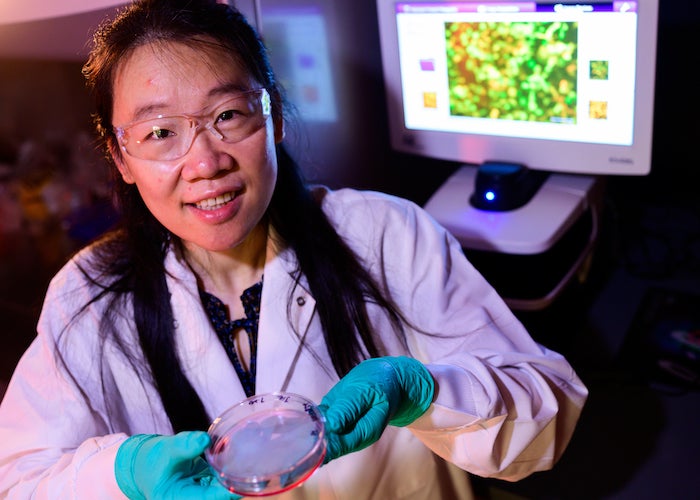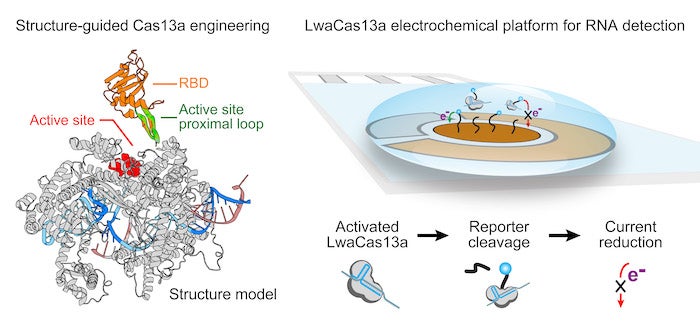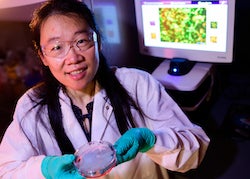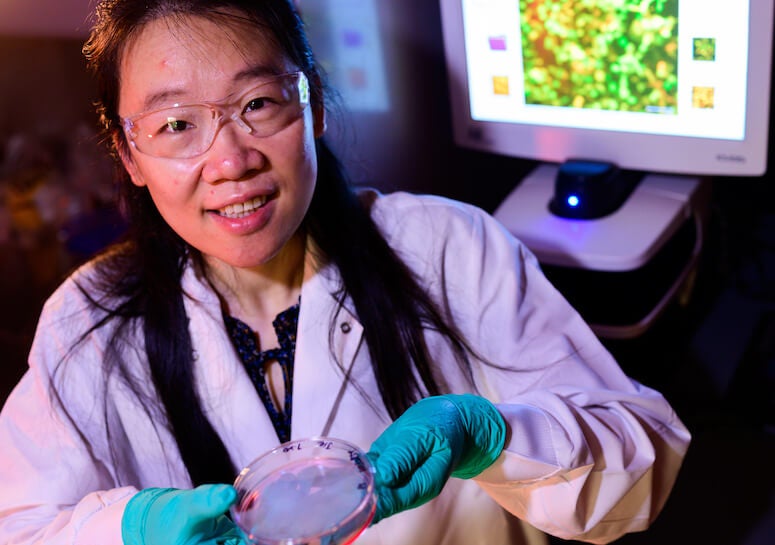HOUSTON – (Sept. 22, 2022) –An engineered CRISPR-based method that finds RNA from SARS-CoV-2, the virus that causes COVID-19, promises to make testing for that and other diseases fast and easy.
Collaborators at Rice University and the University of Connecticut further engineered the RNA-editing CRISPR-Cas13 system to boost their power for detecting minute amounts of the SARS-CoV-2 virus in biological samples without the time-consuming RNA extraction and amplification step necessary in gold-standard PCR testing.

The new platform was highly successful compared to PCR, finding 10 out of 11 positives and no false positives for the virus in tests on clinical samples directly from nasal swabs. The researchers showed their technique finds signs of SARS-CoV-2 in attomolar (10-18) concentrations.
The study led by chemical and biomolecular engineer Xue Sherry Gao at Rice’s George R. Brown School of Engineering and postdoctoral researchers Jie Yang of Rice and Yang Song of Connecticut appears in Nature Chemical Biology.
Cas13, like its better-known cousin Cas9, is part of the system by which bacteria naturally defend themselves against invading phages. Since its discovery, CRISPR-Cas9 has been adapted by scientists to edit living DNA genomes and shows great promise to treat and even cure diseases.
And it can be used in other ways. Cas13 on its own can be enhanced with guide RNA to find and snip target RNA sequences, but also to find “collateral,” in this case the presence of viruses like SARS-CoV-2.
“The engineered Cas13 protein in this work can be readily adapted to other previously established platforms,” Gao said. “The stability and robustness of engineered Cas13 variants make them more suitable for point-of-care diagnostics in low-resource setting areas when expensive PCR machines are not available.”
Yang said wild-type Cas13, drawn from a bacterium, Leptotrichia wadei, cannot detect attomolar level of viral RNA within a time frame of 30 to 60 minutes, but the enhanced version created at Rice does the job in about half an hour and detects SARS-CoV-2 in much lower concentrations than the previous tests.
She said the key is a well-hidden, flexible hairpin loop near Cas13’s active site. “It’s in the middle of the protein near the catalytic site that determines Cas13’s activity,” Yang said. “Since Cas13 is large and dynamic, it was challenging to find a site to insert another functional domain.”

The researchers fused seven different RNA binding domains to the loop, and two of the complexes were clearly superior. When they found their targets, the proteins would fluoresce, revealing the presence of the virus.
“We could see the increased activity was five- or six-fold over wild-type Cas13,” Yang said. “This number seems small, but it’s quite astonishing with a single step of protein engineering.
“But that was still not enough for detection, so we moved the whole assay from a fluorescence plate reader, which is quite large and not available in low-resource settings, to an electrochemical sensor, which has higher sensitivity and can be used for point-of-care diagnostics,” she said.
With the off-the-shelf sensor, Yang said the engineered protein was five orders of magnitude more sensitive in detecting the virus compared to the wild-type protein.
The lab wants to adapt its technology to paper strips like those in home COVID-19 antibody tests, but with much higher sensitivity and accuracy. “We hope that will make testing more convenient and with lower cost for many targets,” Gao said.
The researchers are also investigating improved detection of the Zika, dengue and Ebola viruses and predictive biomarkers for cardiovascular disease. Their work could lead to rapid diagnosis of the severity of COVID-19.

“Different viruses have different sequences,” Yang said. “We can design guide RNA to target a specific sequence that we can then detect, which is the power of the CRISPR-Cas13 system.”
But because the project began just as the pandemic took hold, SARS-CoV-2 was a natural focus. “The technology is quite amenable to all the targets,” she said. “This makes it a very good option to detect all kinds of mutations or different coronaviruses.”
“We are very excited about this work as a combinational effort of structure biology, protein engineering and biomedical device development,” Gao added. “I greatly appreciate all the efforts from my lab members and collaborators.”
Co-authors of the paper are Rice postdoctoral researcher Xiangyu Deng, undergraduate Jeffrey Vanegas and graduate student Zheng You; graduate students Yuxuan Zhang and Zhengyan Weng of the University of Connecticut; microbiology supervisor Lori Avery and Kevin Dieckhaus, a professor of medicine, of UConn Health; Yi Zhang, an assistant professor of biomedical engineering at the University of Connecticut; and Yang Gao, an assistant professor of biosciences at Rice.
Xue Sherry Gao is the Ted N. Law Assistant Professor of Chemical and Biomolecular Engineering at Rice.
The National Science Foundation (2031242, 2103025), the Welch Foundation (C-1952, C-2033-20200401), and the Cancer Prevention and Research Institute of Texas (RR190046) supported the research.
- Peer-reviewed research
-
Engineered LwaCas13a with enhanced collateral activity for nucleic acid detection: https://doi.org/10.1038/s41589-022-01135-y.
- Images for download
-

https://news-network.rice.edu/news/files/2022/08/0822_COVID-1-WEB.jpg
Rice University postdoctoral researcher Jie Yang led an effort to adapt Cas13 genome editing tools to serve as a highly sensitive detector for the presence of the SARS-CoV-2 virus, which causes COVID-19. (Credit: Jeff Fitlow/Rice University)

https://news-network.rice.edu/news/files/2022/09/0822_COVID-2-WEB.jpg
Using structure-guided Cas13, researchers at Rice University and the University of Connecticut modified a gene editing tool to serve as a highly sensitive diagnostic test for the presence of the SARS-CoV-2 virus. They used an off-the-shelf electrochemical sensor to deliver results. (Credit: Jie Yang/Rice University)

https://news-network.rice.edu/news/files/2022/09/0822_COVID-4-WEB.jpg
From left, Rice University undergraduate student Jeffrey Vanegas, chemical and biomolecular engineer Xue Sherry Gao and postdoctoral researcher Jie Yang led the effort to modify a gene editing tool to serve as a diagnostic test for the presence of the SARS-CoV-2 virus. (Credit: Rice University)
- Related materials
-
The Gao Laboratory: https://gaolab.rice.edu
Chemical and Biomolecular Engineering: https://chbe.rice.edu/
George R. Brown School of Engineering: https://engineering.rice.edu
- About Rice
-
Located on a 300-acre forested campus in Houston, Rice University is consistently ranked among the nation’s top 20 universities by U.S. News & World Report. Rice has highly respected schools of Architecture, Business, Continuing Studies, Engineering, Humanities, Music, Natural Sciences and Social Sciences and is home to the Baker Institute for Public Policy. With 4,240 undergraduates and 3,972 graduate students, Rice’s undergraduate student-to-faculty ratio is just under 6-to-1. Its residential college system builds close-knit communities and lifelong friendships, just one reason why Rice is ranked No. 1 for lots of race/class interaction and No. 1 for quality of life by the Princeton Review. Rice is also rated as a best value among private universities by Kiplinger’s Personal Finance.

